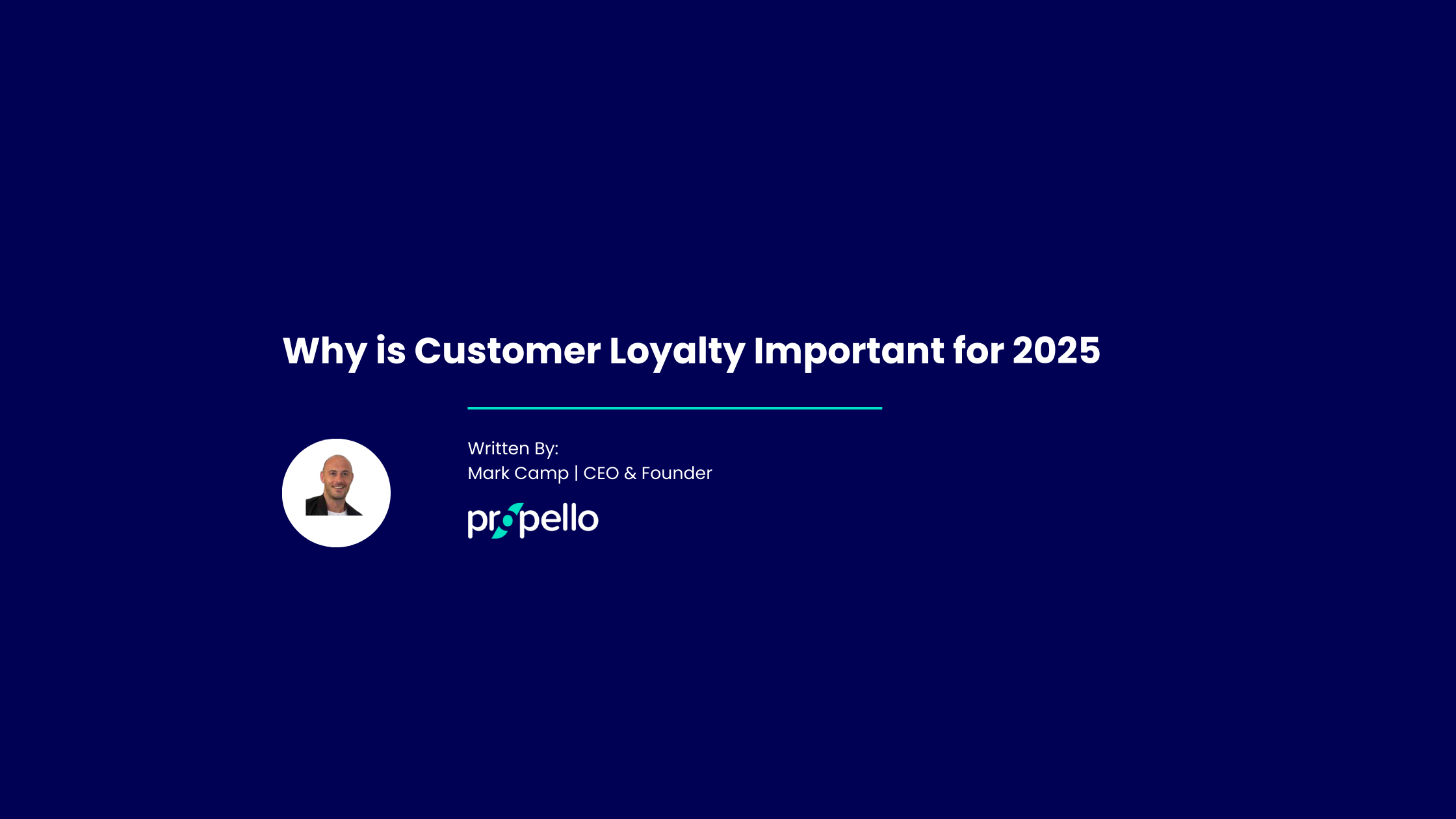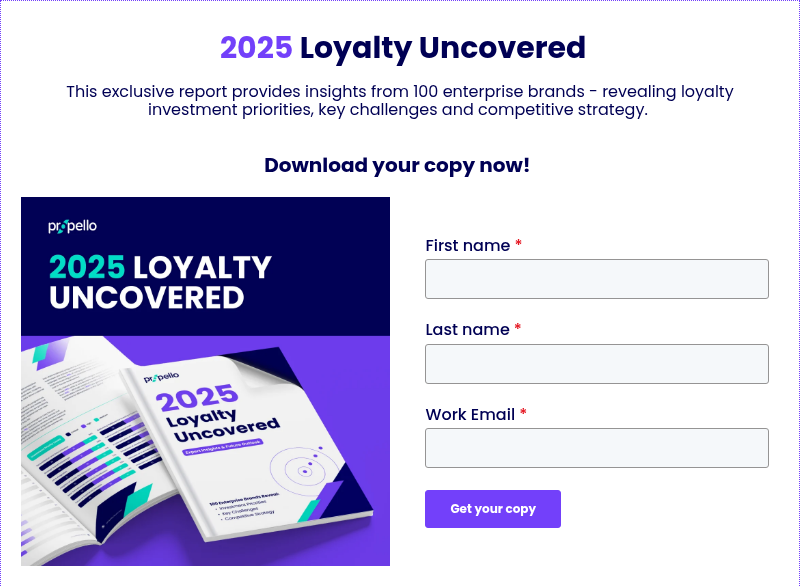Key Takeaways
Customer loyalty drives sustainable business growth through:
-
Acquisition costs 25x higher than retention, making loyal customers more economically valuable.
-
Engaged customers spending 31% more and being 50% more likely to try new products.
-
Self-service communities reduce support costs with 77% of customers preferring this approach.
-
Reviews influencing 86% of purchase decisions.
-
Brand advocates reaching 6,000+ potential customers through referral programmes.
-
Loyalty programmes increased retention by up to 78%.
What is Customer Loyalty?
Customer loyalty represents the strength of the relationship between your brand and your customers. While traditional metrics like purchase frequency and social media engagement are important indicators, true loyalty emerges from a deeper connection that drives sustainable commercial value.
Through our enterprise partnerships, we've consistently seen that customers who engage with loyalty programmes are 5x more valuable than non-engaged users. Real transformation happens when brands move beyond transactional relationships to create meaningful, lasting connections.
Emotional Connection
Customers become part of your story when they feel personally invested in your brand's journey. Data shows that customers who form an emotional connection with brands significantly engage in referral activities.
Brand Trust
Trust is earned through reliable customer service but it's also built on top of consistent delivery of your value proposition. In the digital age, trust extends beyond traditional face-to-face interactions into every touchpoint of the customer journey. When trust forms, it drives sustainable growth because customers typically become more invested in your brand's ecosystem, leading to increased engagement and advocacy.
Customer Behaviour Patterns
Understanding customer behaviour patterns through data-driven insights leads towards hyper-relevant engagement strategies. Analysing metrics like purchase frequency, engagement metrics, and referral patterns across the customer base, businesses can identify and cultivate their most valuable customer segments.
Such insights drive personalised experiences that transform casual buyers into brand advocates through tailored rewards and strategic brand partnerships.
Customer Experience & Journey
In today's market, great products or services alone don't guarantee success. Research from Rare Consulting backs up my previous point emphasising the importance of trust:
83% of customers say their customer loyalty started with trust in a brand.
Remember, the modern customer journey goes beyond transactional interactions. Your customer base seeks meaningful engagement at every touchpoint, from their first interaction to becoming active brand advocates.
What's fascinating is how positive experiences catalyse word-of-mouth marketing. The reason behind it is customers feeling valued. Personalised experiences are a great way of helping customers naturally become advocates for your brand, sharing their experiences with friends and family.
Organic advocacy, powered by strategic brand partnerships and hyper-relevant engagement, creates a sustainable cycle of growth through both customer retention and acquisition.
Building Customer Loyalty: The 6 Essential Stages
Understanding the customer journey is fundamental to driving growth through loyalty. Here are the six critical stages that see prospects progress towards brand advocacy.
1. Awareness
This initial stage is where prospects recognise a need that your products or services could fulfill. Our experience shows that aligning your value proposition with customer pain points creates stronger initial connections.
2. Research
During this critical evaluation phase, prospects engage with customer feedback, online reviews, and seek recommendations from friends and family. Your brand reputation needs to shine through with authentic social proof and compelling value propositions that demonstrate deep understanding of customer needs.
3. Purchase
The purchase decision hinges on trust signals and first impressions. Quality customer service at this stage sets the foundation for long-term customer loyalty. The quality of products or services also play a major part in customer satisfaction. Just remember that 93% of customers reward excellent customer service with repeat purchases. First impressions are key to unlocking trust of increasingly sceptical consumers.
4. Experience
This is the turning point. Delivering exceptional customer experiences validates the customer’s purchase decision. Through strategic brand partnerships and personalised engagement, we help brands create memorable moments that strengthen these emotional connections and connotations.
5. Repeat
Converting one-time buyers into repeat purchases requires consistent value delivery. Loyalty programmes must focus on maintaining engagement through hyper-relevant rewards and recognition, driving sustainable customer retention.
6. Refer
Existing customers become your most powerful marketing asset. Research shows that 72% of customers will tell six or more people about a satisfying experience, making brand advocates a crucial driver of organic growth.
Strategic incentives and meaningful customer engagement motivates loyal customers into becoming active brand ambassadors. Advocates drive word-of-mouth marketing, creating new revenue streams while maintaining their own high customer lifetime value.
What’s more, satisfied customers tend to be more receptive to additional engagement opportunities. So, by leveraging strategic loyalty programmes and referral programmes, enterprises can create a sustainable cycle of growth.
Experience Enhancement
In my conversations with enterprise leaders, one theme consistently emerges: the evolution of customer expectations demands a more sophisticated approach to engagement. Through our work with major brands, we've seen firsthand how enhanced experiences directly impact customer loyalty and commercial outcomes.
Personalisation
Gone are the days of one-size-fits-all loyalty programmes. Today's customer engagement hinges on hyper-relevant experiences that resonate on an individual level. Identifying behaviour patterns helps enterprises deliver personalised rewards, strengthening emotional connections and driving repeat purchases.
The key is understanding that personalised experiences are more than addressing a customer by name in communications. Rather, it’s crafting unique customer journeys that align with individual preferences and behaviours, ultimately cultivating deeper brand trust and increasing customer lifetime value.
Omnichannel Engagement
Modern customer relationships thrive on seamless interactions across all touchpoints. Through strategic brand partnerships and integrated technology, a key driver of customer loyalty, we enable enterprises to maintain consistent engagement whether customers interact through social media, mobile apps, or physical locations.
This unified approach to customer service ensures your existing customers receive the same high-quality experience regardless of channel, strengthening brand loyalty and encouraging word-of-mouth marketing. The result? A more engaged customer base that naturally evolves into passionate brand advocates.
The Business Impact of Customer Loyalty
Converting prospects into advocates requires huge investments of time and resources. Let's examine why customer loyalty is critically important for your business, with tangible ROI metrics that demonstrate the benefits of loyalty.
1) Reduces cost of service
Customer service has evolved beyond traditional support models. Self-service now dominates how existing customers resolve issues, particularly for software and specialist products in niche markets. Through online communities, forums, and discussion boards, users connect organically around your brand to share expertise and solutions.
Recent data reinforces this shift in customer behaviour, with 77% of customers favouring self-service options and 60% preferring FAQs over direct representative contact.
By implementing strategic loyalty programmes that incentivise community participation, enterprises gain numerous advantages. First, they secure 24/7 customer support at minimal operational cost. Second, they cultivate vibrant user communities that strengthen brand trust. Finally, they enhance domain authority through user-generated expertise.
This approach turns passive users into active participants in your customer experience, creating sustainable support ecosystems that scale with your business.
2) Better Reviews
Satisfied customers become powerful advocates through their reviews, a critical touchpoint during the prospect's customer journey. In today's market, authentic customer feedback carries more weight than traditional marketing messages, as consumers prioritise real experiences from fellow customers over promotional content.
The data underscores the impact of reviews on customer behaviour. An overwhelming 86% of consumers consult testimonials before making purchase decisions, while 85% consider star ratings the deciding factor. Furthermore, 89% of prospects are more likely to engage with businesses that demonstrate responsive customer service.
Reviews transcend mere social proof. They create opportunities for meaningful customer engagement. Responding to positive feedback and addressing concerns promptly strengthens emotional connections with your customer base. A human touch in customer experience shows potential customers your commitment to lasting customer relationships.
3) Additional Purchase Opportunities
Strategic touchpoint incentives build brand trust, creating opportunities for expanded customer relationships. When loyal customers experience consistent value from one product, they're naturally inclined to explore your broader offering. This trust-based approach proves particularly valuable for enterprises with diverse products or services.
The numbers tell a compelling story about the power of customer loyalty. While loyal customers typically comprise just 20% of your customer base, they generate an impressive 80% of revenue. The contrast in conversion rates is equally striking - new customer sales hover between 5-20%, while existing customers convert at 60-70%. Moreover, these established customers show 50% higher likelihood of trying new products.
This natural progression from repeat purchases to broader product adoption makes customer retention a powerful driver of margin improvement, especially for businesses offering product ranges or tiered subscription services.
4) Increased Profits
Customer loyalty forms the foundation of sustainable business growth, built on the strength of brand trust and consistent customer experiences. Through strategic loyalty programmes that continuously improve and reward engagement, enterprises create meaningful connections that directly impact their bottom line.
The impact of well-executed customer loyalty initiatives is clear: 63% of customers actively adjust their spending to maximise rewards and benefits, while loyalty programmes drive increased spending across 54% of customer bases. Most notably, loyal customers spend an average of 31% more than new customers. Meaningful customer engagement naturally evolves into increased customer value, as people tend to support and invest in brands they trust.
5) Higher Retention
While many enterprises initially focus on acquisition, sustainable growth demands a balanced approach to customer loyalty. Most businesses recognise that acquiring new customers costs more than retaining existing ones, making strategic customer retention crucial for long-term success.
The key lies in mapping the customer journey and implementing targeted retention strategies at each touchpoint. The results speak volumes: companies utilizing loyalty programmes see retention rates increase by up to 78%, and 82% of businesses confirm that retention proves more cost-effective than acquisition. Even more compelling, a mere 5% improvement in customer retention can drive a 25% increase in profits.
6) Brand Advocacy
Consider the impact when a friend endorses your recommendation - this personal validation captures the essence of brand advocacy. For businesses, turning loyal customers into active advocates creates exponential growth opportunities.
The reach of brand advocates through social media and referral programmes is remarkable: just 10 advocates can connect with 6,000 potential customers. With 90% of consumers trusting recommendations from friends and family, these authentic endorsements carry unprecedented weight in purchase decisions.
Strong customer loyalty unlocks powerful marketing channels through word-of-mouth marketing and social proof. When satisfied customers share their customer experiences, they create genuine connections that traditional marketing simply cannot match. Through strategic advocacy programmes, enterprises transform their most engaged customers into growth engines for sustainable business expansion.
7) Growth Metrics
Measuring customer loyalty requires sophisticated tracking beyond basic sales figures. Key performance indicators include purchase frequency, customer lifetime value, and engagement levels across touchpoints. By analysing these customer behaviour patterns, enterprises can identify growth opportunities and optimise their loyalty programmes for maximum impact.
Through our work with major brands, we've found that combining traditional metrics with customer feedback and behavioural data provides deeper insights into loyalty's impact on business growth. This comprehensive approach to measurement enables strategic decisions that drive sustainable expansion.
8) Competitive Advantages
Strong customer loyalty creates natural barriers against competition. When customers form deep emotional connections with your brand, they become less price-sensitive and more resistant to competitive offerings. Loyal customers also provide invaluable market intelligence through their customer experiences and feedback.
Beyond retention, these lasting customer relationships give enterprises significant advantages in new market entries and product launches. The trust established through consistent customer service and value delivery creates a foundation for sustained competitive edge.
9) Marketing Stability
A robust base of loyal customers provides predictable revenue streams, essential for long-term business planning. During market fluctuations, these established customer relationships offer stability through consistent repeat purchases and steady engagement.
This stability extends beyond financial metrics - strong brand trust helps weather market disruptions and economic uncertainties. By maintaining focus on customer retention and nurturing lasting relationships, enterprises build resilience into their business model while creating sustainable paths for growth.
Final Thoughts
Customer loyalty isn’t just a nice-to-have — it’s a strategic asset that drives long-term growth, stabilises revenue, and turns everyday customers into powerful brand advocates. As expectations continue to rise, businesses that prioritise loyalty through trust, personalisation, and meaningful engagement will be the ones that thrive.
Want to see how leading brands are redefining loyalty in 2025?
👉 Download our latest report, Loyalty Uncovered 2025 — your go-to guide for the most important trends, insights, and innovations shaping customer loyalty today. Packed with real-world examples and expert analysis, it’s a must-read for anyone serious about customer growth and retention.
Frequently Asked Questions
What is the true value of customer loyalty for businesses?
Customer loyalty represents more than repeat purchases - it's a fundamental driver of business growth. Loyal customers typically generate 80% of revenue while comprising only 20% of your customer base. They also cost less to serve and are more likely to advocate for your brand.
How do you measure customer loyalty effectively?
Customer loyalty is measured through key metrics including purchase frequency, customer lifetime value, retention rates, and engagement levels. Track both behavioural data (purchases, interactions) and attitudinal data (satisfaction scores, feedback) to get a complete picture.
What role does personalisation play in building customer loyalty?
Personalisation creates deeper emotional connections by tailoring experiences to individual preferences and behaviours. It goes beyond using customer names - it involves customising interactions, rewards, and communications based on customer data and engagement patterns.
How can businesses improve customer retention rates?
Improve retention by mapping customer journeys and implementing targeted engagement strategies at each touchpoint. Focus on delivering consistent value through loyalty programmes, personalised experiences, and responsive customer service.
What makes loyalty programmes successful?
Successful loyalty programmes deliver hyper-relevant rewards that align with customer preferences and behaviours. They combine transactional benefits with emotional engagement, creating meaningful experiences that encourage long-term customer relationships.
How does customer advocacy impact business growth?
Customer advocacy drives organic growth through authentic word-of-mouth marketing. When satisfied customers share their experiences, they create genuine connections that traditional marketing cannot match, influencing 90% of purchase decisions.
What's the relationship between customer experience and loyalty?
Customer experience directly influences loyalty by creating emotional connections at every touchpoint. Consistent, positive experiences build trust and encourage repeat engagement, leading to increased customer lifetime value.
How does technology support customer loyalty initiatives?
Technology enables businesses to track customer behaviour, personalise experiences, and deliver omnichannel engagement. It provides insights for optimising loyalty programmes and measuring their impact on business growth.
What role do customer communities play in building loyalty?
Customer communities foster engagement, reduce service costs, and build brand authority. They create spaces for customers to share experiences, provide peer support, and develop stronger connections with your brand.
How can businesses balance acquisition and retention strategies?
While acquisition remains important, businesses should invest in retention through loyalty programmes and personalised engagement. Focus on converting new customers into loyal advocates while nurturing existing customer relationships.
Mark Camp | CEO & Founder at PropelloCloud.com | LinkedIn
Mark is the Founder and CEO of Propello Cloud, an innovative SaaS platform for loyalty and customer engagement. With over 20 years of marketing experience, he is passionate about helping brands boost retention and acquisition with scalable loyalty solutions.
Mark is an expert in loyalty and engagement strategy, having worked with major enterprise clients across industries to drive growth through rewards programmes. He leads Propello Cloud's mission to deliver versatile platforms that help organisations attract, engage and retain customers.





.png)